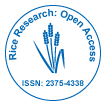当社グループは 3,000 以上の世界的なカンファレンスシリーズ 米国、ヨーロッパ、世界中で毎年イベントが開催されます。 1,000 のより科学的な学会からの支援を受けたアジア および 700 以上の オープン アクセスを発行ジャーナルには 50,000 人以上の著名人が掲載されており、科学者が編集委員として名高い
。オープンアクセスジャーナルはより多くの読者と引用を獲得
700 ジャーナル と 15,000,000 人の読者 各ジャーナルは 25,000 人以上の読者を獲得
インデックス付き
- 索引コペルニクス
- Google スカラー
- Jゲートを開く
- アカデミックキー
- 電子ジャーナルライブラリ
- レフシーク
- 研究ジャーナル索引作成ディレクトリ (DRJI)
- ハムダード大学
- エブスコ アリゾナ州
- OCLC-WorldCat
- 学者の舵取り
- SWBオンラインカタログ
- 仮想生物学図書館 (vifabio)
- パブロン
- ユーロパブ
役立つリンク
オープンアクセスジャーナル
このページをシェアする
抽象的な
Comparisons of Cooking and Eating Qualities of Two Indica Rice Cultivars
Nnaemeka Emmanuel Okpala, Lixin Duan, Guoan Shen, Guiquan Zhang and Xiaoquan Qi
The cooking and eating qualities of rice are some of the problems facing by rice producers and consumers around the world. In this study we investigated the cooking and eating qualities of Basmati 385 and Hua Jing Xian 74. Both are rice cultivars with different phenotypic traits.
The results show that Basmati 385 increased by an average of 102.14% after cooking while Hua Jing Xian 74 increased by an average of 69.91% after cooking. Basmati 385 had a pasting temperature of 78°C, while Hua Jing Xian 74 had a pasting temperature of 84°C. However, Hua Jing Xian 74 had a final viscosity of 4,686 cP while Basmati 385 had a final viscosity of 3,514 cP. The amylose contents of the two cultivars were also different; Hua Jing Xian 74 had an amylose content of 19.4%, while that of Basmati 385 was 18%. We also discovered that the starch granule morphology of the two cultivars were remarkably different.
The lower pasting temperature of Basmati 385 positively correlated with good cooking qualities of rice. However, Hua Jing Xian 74 appears to have relatively better eating qualities due to its higher viscosity and higher amylose content. It would be pertinent to do more research about hybrid lines resulting from a cross of Hua Jing Xian 74 and Basmati 385, to see if they possess the good cooking qualities of Basmati 385 and the good eating qualities of Hua Jing Xian 74.

 English
English  Spanish
Spanish  Chinese
Chinese  Russian
Russian  German
German  French
French  Portuguese
Portuguese  Hindi
Hindi